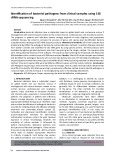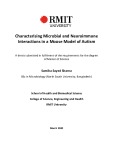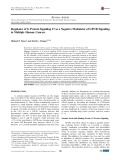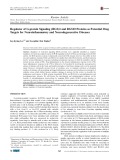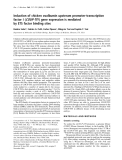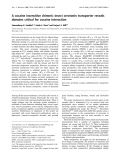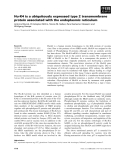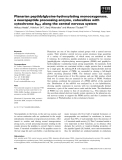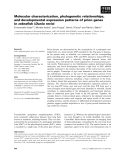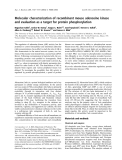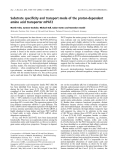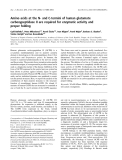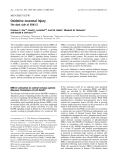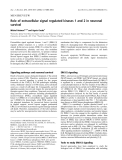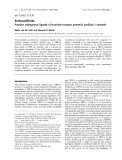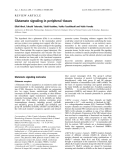
Nervous system
-
Bacterial infections have a substantial impact on global health and can become serious if misdiagnosed with several diseases related to the central nervous, cardiovascular, and respiratory systems. The prognosis in patients with infectious disease strongly depends on early diagnosis and appropriate antibiotic therapy. We aimed to compare the accuracy of genus and species-level identification bacteria using biochemical testing and 16S rRNA sequence analysis.
 8p
8p  viharuno
viharuno
 03-01-2025
03-01-2025
 3
3
 2
2
 Download
Download
-
The aims of the study "Characterising microbial and neuroimmune interactions in a mouse model of autism" are threefold: i) To characterize the influence of the R451C mutation on caecal enteric neuron organization; ii) To characterize the influence of the R451C mutation on caecal patch macrophage density and morphology; iii) To assess for alterations in gut microbes in different regions of the GI tract in the NL3R451C mouse model of autism.
 83p
83p  runthenight04
runthenight04
 02-02-2023
02-02-2023
 10
10
 2
2
 Download
Download
-
"Master's thesis of Science: Intestinal permeability and functional properties of duodenal enteric neurons in a mouse model of autism" is structured as follows: Chapter 1: Introduction; Chapter 2: Measuring intestinal permeability in the Neuroligin-3R451C mouse model of autism; Chapter 3: Optimisation of the patch-clamp recording technique in the enteric nervous system to examine action potential characteristics in mouse duodenal myenteric neurons.
 147p
147p  runthenight04
runthenight04
 02-02-2023
02-02-2023
 11
11
 4
4
 Download
Download
-
Regulators of G protein signaling (RGS) proteins modulate G protein-coupled receptor (GPCR) signaling networks by terminating signals produced by active Gα subunits. RGS17, a member of the RZ subfamily of RGS proteins, is typically only expressed in appreciable amounts in the human central nervous system, but previous works have shown that RGS17 expression is selectively upregulated in a number of malignancies, including lung, breast, prostate, and hepatocellular carcinoma.
 10p
10p  caothientrangnguyen
caothientrangnguyen
 09-05-2020
09-05-2020
 13
13
 1
1
 Download
Download
-
Regulator of G-protein signaling (RGS) proteins were originally identified as negative regulators of G-protein-coupled receptor (GPCR) signaling via their GTPase-accelerating protein (GAP) activity. All RGS proteins contain evolutionarily conserved RGS domain; however, they differ in their size and regulatory domains. RGS1 and RGS10 are smaller than other RGS proteins, and their functions involve various inflammatory responses including autoimmune responses in both the periphery and the central nervous system (CNS). Neuroinflammation is the chronic inflammatory response in the CNS.
 5p
5p  caothientrangnguyen
caothientrangnguyen
 09-05-2020
09-05-2020
 30
30
 2
2
 Download
Download
-
Regulator of G protein signaling (RGS) proteins are gatekeepers regulating the cellular responses induced by G protein-coupled receptor (GPCR)-mediated activation of heterotrimeric G proteins. Specifically, RGS proteins determine the magnitude and duration of GPCR signaling by acting as a GTPase-activating protein for Gα subunits, an activity facilitated by their semiconserved RGS domain. The R7 subfamily of RGS proteins is distinguished by two unique domains, DEP/DHEX and GGL, which mediate membrane targeting and stability of these proteins.
 13p
13p  caothientrangnguyen
caothientrangnguyen
 09-05-2020
09-05-2020
 30
30
 1
1
 Download
Download
-
Theo nghĩa sinh học, mạng nơ-ron là một tập hợp các dây thần kinh kết nối với nhau. Ngày nay, thuật ngữ này còn dùng để chỉ mạng nơ-ron nhân tạo, cấu thành từ các nơ-ron nhân tạo. Do đó thuật ngữ 'mạng nơ-ron' xác định hai khái niệm phân biệt: Mạng nơ-ron sinh học là một mạng lưới (plexus) các nơ-ron có kết nối hoặc có liên quan về mặt chức năng trực thuộc hệ thần kinh ngoại biên (peripheral nervous system) hay hệ thần kinh trung ương (central nervous system). Trong ngành thần kinh học...
 13p
13p  and_12
and_12
 08-08-2013
08-08-2013
 87
87
 10
10
 Download
Download
-
Chickenovalbuminupstreampromoter-transcriptionfactorI (COUP-TFI, or NR2F1) is an orphan nuclear receptor that plays amajor role in the development of the nervous system. We show here that three ETS response elements in the COUP-TFIpromoter mediate its transcription. A reporter gene containing theseETSbinding sites is activatedbyEts-1, while the same reporter with point mutations on all three ETS response elements is not.
 9p
9p  research12
research12
 29-04-2013
29-04-2013
 28
28
 3
3
 Download
Download
-
Serotonin transporters are key target sites for clinical drugs and psychostimulants, such as fluoxetine and cocaine. Molecular cloning of a serotonin transporter from the cen-tral nervous system of the insectManduca sextaenabled us to define domains that affect antagonist action, particularly cocaine.
 11p
11p  research12
research12
 23-04-2013
23-04-2013
 35
35
 1
1
 Download
Download
-
Tachykinins and tachykinin-related peptides (TKRPs) play major roles in signaling in the nervous system and intestine of both invertebrates and ver-tebrates. Here we have identified cDNAs encoding precursors of multiple TKRPs from the cockroachesLeucophaea maderaeandPeriplaneta ameri-cana. All nine LemTKRPs that had been chemically isolated in earlier experiments could be identified on the precursor ofL. maderae. Four previ-ously unidentified LemTKRPs were found in addition on the precursor.
 11p
11p  fptmusic
fptmusic
 11-04-2013
11-04-2013
 34
34
 1
1
 Download
Download
-
Hu-K4 is a human protein homologous to the K4L protein of vaccinia virus. Due to the presence of two HKD motifs, Hu-K4 was assigned to the family of Phospholipase D proteins although so far no catalytic activity has been shown. The Hu-K4 mRNA is found in many human organs with highest expression levels in the central nervous system. We extended the ORF of Hu-K4 to the 5¢ direction. As a consequence the protein is 53 amino acids larger than originally predicted, now harbouring a putative transmembrane domain....
 0p
0p  awards
awards
 06-04-2013
06-04-2013
 39
39
 3
3
 Download
Download
-
Planarians are one of the simplest animal groups with a central nervous system. Their primitive central nervous system produces large quantities of a variety of neuropeptides, of which many are amidated at their C terminus. In vertebrates, peptide amidation is catalyzed by two enzymes [peptidylglycine a-hydroxylating monooxygenase (PHM) and peptidyl-a-hydroxylglycinea-amidating lyase] acting sequentially. In mammals, both enzymatic activities are contained within a single protein that is encoded by a single gene....
 14p
14p  awards
awards
 05-04-2013
05-04-2013
 42
42
 4
4
 Download
Download
-
Prion diseases are characterized by the accumulation of a pathogenic mis-folded form of a prion protein (PrP) encoded by the Prnpgene in humans. In the present study in zebrafish, two transcripts and the corresponding genes encoding prion proteins, PrP1 and PrP2, related to human PrP have been characterized with a relatively divergent deduced amino acid sequence, but a well preserved overall organization of structural prion pro-tein motifs.
 14p
14p  awards
awards
 05-04-2013
05-04-2013
 41
41
 2
2
 Download
Download
-
The regulation of adenosine kinase (AK) activity has the potential to control intracellular and interstitial adenosine (Ado) concentrations. In an effort to study the role of AK in Ado homeostasis in the central nervous system, two iso-forms of the enzymewere cloned fromamouse brain cDNA library. Following overexpression in bacterial cells, the cor-responding proteins were purified to homogeneity.
 9p
9p  awards
awards
 05-04-2013
05-04-2013
 42
42
 3
3
 Download
Download
-
The PAT2 transporter has been shown to act as an electro-genic proton/amino acid symporter. The PAT2 cDNA has been cloned fromvarious human, mouse and rat tissues and belongs to a group of four genes (pat1topat4)withPAT3 and PAT4 still resembling orphan transporters. The first immunolocalization studies demonstrated that the PAT2 protein is found in the murine central nervous system in neuronal cells with a proposed role in the intra and/or intercellular amino acid transport.
 8p
8p  awards
awards
 05-04-2013
05-04-2013
 54
54
 5
5
 Download
Download
-
Human glutamate carboxypeptidase II (GCPII) is a co-catalytic metallopeptidase and its putative catalytic domain is homologous to the aminopeptidases fromVibrio proteolyticus and Streptomyces griseus.In humans, the enzyme is expressed predominantly in the nervous system and theprostate.Theprostate form, termedprostate-specific membraneantigen, is overexpressed inprostate cancer and is used as a diagnostic marker of the disease.II
 9p
9p  dell39
dell39
 03-04-2013
03-04-2013
 39
39
 4
4
 Download
Download
-
The extracellular signal regulated protein kinases (ERK1/2) are essential for normal development and functional plasti-city of the central nervous system. However, a growing number of recent studies in models of cerebral ischemia, brain trauma and neurodegenerative diseases implicate a detrimental role for ERK1/2 signaling during oxidative neuronal injury. Neurons undergoing oxidative stress-rela-ted injuries typically display a biphasic or sustained pattern of ERK1/2 activation.
 7p
7p  dell39
dell39
 03-04-2013
03-04-2013
 41
41
 3
3
 Download
Download
-
Extracellular signal regulated kinases 1 and 2 (ERK1/2) regulate cellular responses to a varietyof extracellular stimuli. In the nervous system, ERK1/2 is critical for neur-onal differentiation, plasticityand mayalso modulate neuronal survival. In this minireview, we present evidence that supports prosurvival activityof ERK1/2 in neurons. Several reports suggest that ERK1/2 mediates neuropro-tective activityof extracellular factors, including neurotro-phins. In addition, ERK1/2 is activated byneuronal injury....
 6p
6p  dell39
dell39
 03-04-2013
03-04-2013
 31
31
 3
3
 Download
Download
-
Endovanilloids are defined as endogenous ligands of the transient receptor potential vanilloid type 1 (TRPV1) protein,a nonselective cation channel that belongs to the large family of TRP ion channels,and is activated by the pungent ingredient of hot chilli peppers,capsaicin. TRPV1 is expressed in some nociceptor efferent neurons, where it acts as a molecular sensor of noxious heat and low pH. However,the presence of these channels in var-ious regions of the central nervous system,where they are not likely to be targeted by these noxious stimuli,suggests the existence of endovanilloids.
 8p
8p  dell39
dell39
 03-04-2013
03-04-2013
 43
43
 2
2
 Download
Download
-
The hypothesis thatL-glutamate (Glu) is an excitatory amino acid neurotransmitter in the mammalian central nervous system is now gaining more support after the suc-cessful cloning of a number of genes coding for the signaling machinery required for this neurocrine at synapses in the brain. These include Glu receptors (signal detection), Glu transporters (signal termination) and vesicular Glu trans-porters (signal output through exocytotic release).
 13p
13p  dell39
dell39
 03-04-2013
03-04-2013
 64
64
 4
4
 Download
Download
CHỦ ĐỀ BẠN MUỐN TÌM








